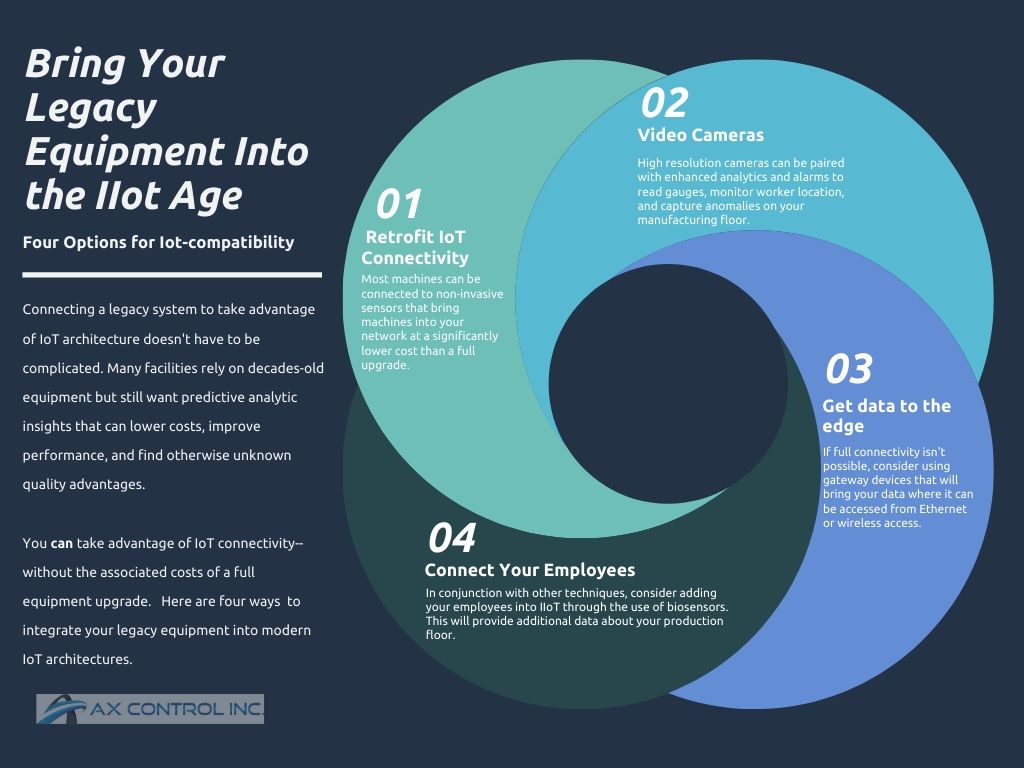
There are reasons to bring legacy equipment into the Industrial Internet of Things (IIot) Age.
Most manufacturers work with older equipment. A 2017 McKinsey report notes factory machinery and tools have an average age of 11 years. Industrial equipment lasts by design; we even use the term “industrial strength” to attribute higher-than-usual durability and power to everything from bug spray to boots. And when something is still working–and working well–a full upgrade to something new can be a difficult sell.
But many of these older legacy systems were created before the age of connected manufacturing systems, which bring with them a number of added benefits. A connected “smart factory” can mean higher productivity, increased flexibility, a safer manufacturing floor, and lower costs.
One option that bridges the gap between a full upgrade and missing out on all these benefits is to perform a retrofit of connected IoT gateway and data feedback devices. But until recently, this kind of upgrade was a complicated and costly affair. But it doesn’t have to be anymore, and more options are available.
What is the Industrial Internet of Things?
IIoT or the Industrial Internet of Things is the industrial extension of IoT. Automation in a traditional factory improves through the use of interconnected smart sensors. Other instruments work with sensors to take advantage of data collection and analysis. This happens on a networked (Internet) platform.
Options for Connecting your Factory Floor
There are several options now available for connecting your legacy systems to the IoT. These include
- Retrofitting IIoT Connectivity. IoT gateways use software, sensors, and industrial-based control systems to provide a simple connection that can send data in real-time.
- Using Video Cameras. Video analytics allow cameras to recognize objects, people, or issues on your floor automatically.
- Using Edge Devices. Data can be accessed via local devices. This can improve security and provide access to process data more quickly.
- Using Biometric Devices. Your employees can become part of your data acquisition through the use of biometric wearables or tags. This works in conjunction with additional upgrades.

Benefits of a Connected Production Floor
When considering a connectivity upgrade, several factors should be considered. Advantages of IIoT connectivity include the following:
- Better Quality-Quickly identify and correct quality issues. In addition, identifying the reason for quality issues becomes easier.
- Increased Flexibility-Forecast demand fluctuations to change configurations as needed.
- Lower Costs-Data allows for efficient inventory control, sourcing, and staffing.
- Higher Productivity-Real-time data on equipment and employee performance lead to streamlined processes and workflows.
What You Should Consider Before You Upgrade
There are significant benefits to upgrading your legacy system with connected IIoT sensors. But a successful transformation relies on planning. Here are three things to consider before you begin:
- Define your goals. Charles Babbage, who came up with the idea of a programmable computer, said that “errors using inadequate data are much less than those using no data at all.” For example, you may have zero experience with IIoT, but you have plenty of experience with your own processes. Start with your key performance indicators and decide where you want to see improvements. You can’t meet a goal you haven’t set.
- Figure out what you don’t know. Where are your current blind spots when it comes to data? In order to find them, sit down with your managers and floor supervisors to understand what they’re struggling to quantify. This may include anything from throughput and production attainment data to machine data that can be used to build a more efficient predictive maintenance schedule.
- Decide on your plan of action. You will need to decide what kind of sensors or data acquisition devices to use. Then, build your network accordingly. If you’re starting from zero connectivity, this may include the installation of Ethernet drops and cables. Make sure to consider the time and cost of this as you make your plans.
Final Thoughts
When faced with a challenge like a factory upgrade it’s easy to slip into an “if it ain’t broke don’t fix it” mentality. But if your competitors move out of their comfort zones before you do, your company gets left behind as they reap the benefits of change.
One thing to keep in mind: upgrading equipment is always going to be a marathon and not a sprint, no matter which path you choose. When you make the decision to do it, know you’re in it for the long haul. And once it’s done, all the hard work, the roller coaster of emotions, and the tough moments should pay off for years to come.
Ready to upgrade your equipment? Talk to AX Control about selling your surplus.

You must be logged in to post a comment.